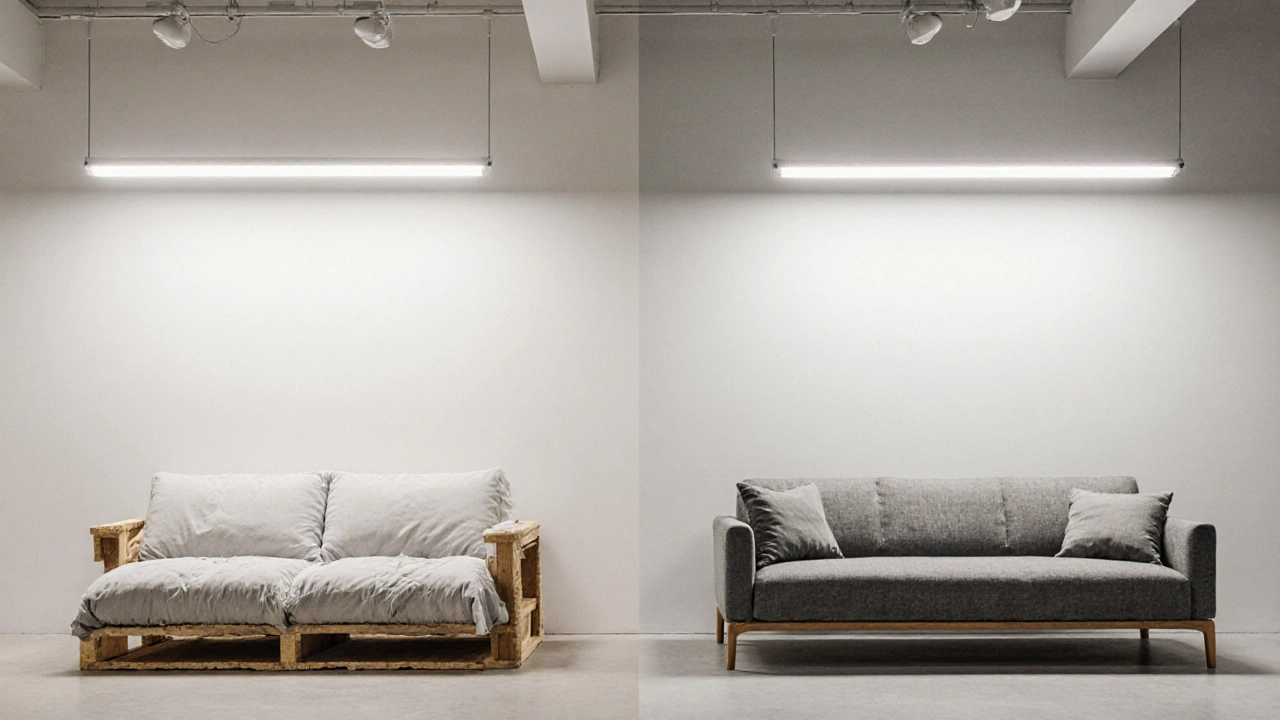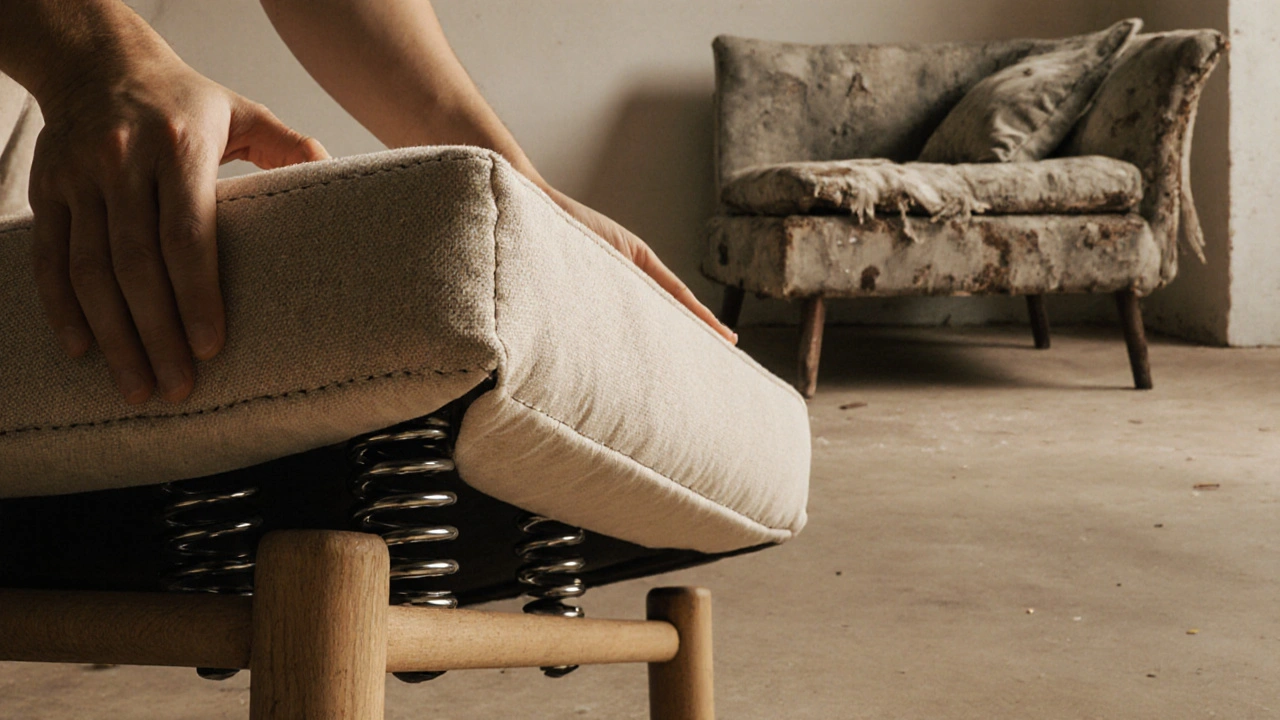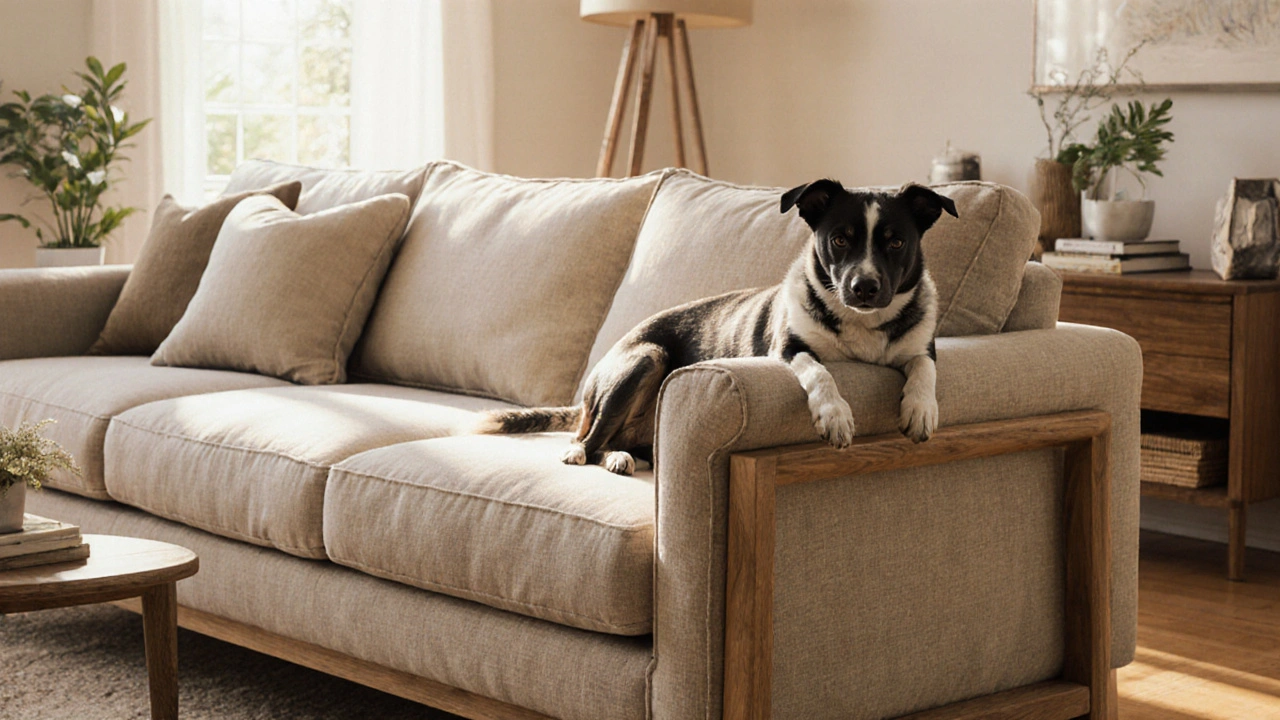Most people buy a sofa once every 10 to 15 years. That means when you spend money on one, you want it to last-not just in style, but in structure. So how much should you really spend? The answer isn’t a single number. It’s a range shaped by how you live, how often you use it, and what you’re willing to replace down the line.
Why You Can’t Just Buy the Cheapest Sofa
A $300 sofa might look great in the showroom, but if the frame is made of particleboard and the cushions are filled with thin foam, it won’t survive a year of regular use. By the time your knees sink through the seat or the legs wobble, you’ll wish you’d spent more upfront. Furniture stores know this. That’s why they push low-priced options-they turn over fast. But here’s the truth: a sofa under $500 rarely holds up well beyond two years. And if you’re replacing it every few years, you’re spending more over time than if you’d bought one that lasts.What Makes a Sofa Actually Good?
Not all sofas are created equal. The difference between a $800 sofa and a $2,000 one isn’t just the fabric. It’s the bones.- Frame: Hardwood like kiln-dried oak, maple, or beech is the gold standard. Avoid particleboard, plywood, or softwoods-they warp and crack. A solid hardwood frame can last 20+ years.
- Joinery: Look for corner blocks, dowels, and screws. Stapled or glued joints? That’s a red flag. The strongest sofas use mortise-and-tenon or double-dowel construction.
- Spring system: Eight-way hand-tied springs are the best. They’re durable, supportive, and don’t sag. Sinuous springs (S-shaped metal coils) are a good mid-tier option. If the sofa only has elastic webbing, skip it.
- Cushion fill: High-density foam (1.8 lb/ft³ or higher) wrapped in down or fiber is ideal. Pure down feels luxurious but flattens fast. Foam-only cushions lose shape after a year. The sweet spot? Foam core with a down blend.
- Fabric: Performance fabrics like Crypton, Sunbrella, or tightly woven polyester blends resist stains and wear. Linen and cotton look great but show dirt and pilling quickly. Leather is durable but requires maintenance. Avoid cheap microfiber-it pills and looks cheap after a few months.
Price Tiers: What You Get at Each Level
There’s a clear split in quality between price ranges. Here’s what you’re actually paying for:| Price Range | Frame | Spring System | Cushion Fill | Fabric Quality | Expected Lifespan |
|---|---|---|---|---|---|
| $300-$600 | Plywood or particleboard | Elastic webbing | Low-density foam (1.2 lb/ft³) | Thin polyester or microfiber | 1-3 years |
| $700-$1,200 | Softwood or mixed hardwood | Sinuous springs | Medium-density foam (1.5-1.8 lb/ft³) | Standard cotton or polyester blend | 5-8 years |
| $1,300-$2,500 | Kiln-dried hardwood | Sinuous or eight-way hand-tied | High-density foam + down blend | Performance fabric or top-grain leather | 10-15+ years |
| $2,600+ | High-grade hardwood (oak, walnut) | Eight-way hand-tied | High-density foam + 50%+ down | European linen, full-grain leather, custom weaves | 15-25+ years |
If you’re buying for a family with kids or pets, skip anything under $1,200. You’ll regret it. For a studio apartment or guest room, $800-$1,000 is fine if you don’t plan to keep it long. But if it’s the centerpiece of your living room and you plan to live there for a decade, aim for $1,500-$2,200. That’s the sweet spot for real value.

Where to Buy for the Best Value
Big-box stores like IKEA or Wayfair offer low prices, but their sofas rarely meet the durability standards above. For a sofa that lasts, look at:- Local upholstery shops: They build to order. You pick the wood, fabric, and cushion firmness. Prices start around $1,500, but you get exactly what you want.
- Direct-to-consumer brands: Companies like Floyd, Burrow, and Article cut out the middleman. Their sofas often use hardwood frames and performance fabrics at $1,400-$2,000.
- Factory outlets and clearance: End-of-season sales at high-end retailers like Crate & Barrel or West Elm can drop prices by 40-60%. A $2,500 sofa can become a $1,000 bargain-if you know what to look for.
Never buy a sofa without testing it. Sit on it. Lean back. Push down on the arms. If it feels flimsy or the cushions compress too easily, walk away. The best deals aren’t the ones with the lowest sticker price-they’re the ones that won’t need replacing in two years.
Is a $3,000 Sofa Worth It?
Yes-if you plan to keep it for 20 years. A $3,000 sofa made with solid walnut, hand-tied springs, and full-grain leather isn’t just furniture. It’s a long-term investment. Think of it like buying a car. A $20,000 car might get you to work, but a $40,000 one will last longer, hold its value, and be more comfortable. The same logic applies here.And here’s something most people don’t think about: resale value. A well-made sofa from a reputable maker can sell for 50-70% of its original price on platforms like Facebook Marketplace or Chairish. A $2,500 sofa might net you $1,500 after five years. That cuts your real cost to just $1,000 over the lifespan.
What to Do If You Can’t Afford a $2,000 Sofa
Budget constraints are real. If $2,000 is out of reach, here’s a smarter path:- Buy a $900-$1,200 sofa with a hardwood frame and sinuous springs.
- Upgrade the cushions later. High-density foam cushions cost $150-$300 to replace. You can do it yourself.
- Use a slipcover. A quality, washable slipcover can hide wear and refresh the look for under $100.
- Wait for sales. Black Friday, Memorial Day, and Labor Day are the best times to buy. Retailers clear old inventory then.
Don’t buy a cheap sofa just to "get by." Buy one that gives you breathing room to upgrade later. That’s the real trick.

How to Spot a Fake "High-Quality" Sofa
Marketing buzzwords like "luxury," "premium," or "artisan-crafted" mean nothing unless you know what to look for. Here’s how to cut through the noise:- Ask for the frame material. If they say "engineered wood," walk away.
- Ask if the springs are hand-tied. If they don’t know, it’s not.
- Check the underside. Lift the cushion. If you see cheap fabric stapled to the frame, it’s a sign of corners being cut.
- Look for a warranty. A 5-year warranty on the frame is standard for quality. Anything less means they don’t trust it.
- Search for reviews mentioning "sagging" or "falling apart." Real customers don’t lie.
The best sofas don’t need flashy names. They need solid construction. And you can see that if you know where to look.
Final Rule: Spend What You Can, But Never Less Than This
If you’re buying a sofa for daily use in a home with people, pets, or kids, don’t spend less than $1,000. Below that, you’re gambling on durability. At $1,000-$1,800, you get a sofa that will last 8-12 years with minimal upkeep. That’s the most cost-effective choice over time.Think of it this way: a $1,200 sofa that lasts 10 years costs $120 per year. A $500 sofa that lasts 3 years costs $167 per year. The cheaper one isn’t saving you money-it’s costing you more.
Is it better to buy a sofa on sale or pay full price?
Always wait for sales. Major retailers drop prices by 30-60% during holidays like Memorial Day, Labor Day, and Black Friday. Even high-end brands like Pottery Barn and West Elm offer seasonal discounts. Paying full price only makes sense if you need it immediately and the sale cycle is over. Otherwise, patience saves you hundreds.
Can I find a good sofa online without testing it?
Yes, but only from brands with free returns and detailed specs. Companies like Burrow, Floyd, and Article offer 100-day trial periods. Read reviews carefully-look for mentions of frame creaking, cushion flattening, or fabric pilling. Avoid sites that don’t list frame material or spring type. If they hide the details, they’re hiding the truth.
Should I buy leather or fabric?
Leather lasts longer and is easier to clean, but it shows scratches and needs conditioning. Fabric is softer and comes in more colors, but stains easily unless it’s performance-grade. For homes with pets or kids, go for performance fabric like Crypton or Sunbrella. They’re stain-resistant, durable, and feel like regular fabric. Leather is better for low-traffic rooms or if you’re willing to maintain it.
Do expensive sofas come with better warranties?
Generally, yes. Quality brands offer 5-10 year warranties on frames and springs. Budget sofas often have 1-year warranties. A strong warranty means the maker stands behind their product. If a company won’t guarantee the frame for at least 5 years, they don’t believe it will last that long.
Is it worth reupholstering an old sofa?
Only if the frame is solid. If the structure is still tight, the springs aren’t broken, and the legs are intact, reupholstering is a smart move. It costs $800-$1,500, but you’re keeping a quality frame. If the frame is wobbly or the springs are flattened, it’s cheaper to replace the whole thing.
Next Steps: What to Do Today
If you’re shopping for a sofa this month:- Write down your must-haves: size, fabric type, color, and how many people sit on it daily.
- Set a realistic budget-aim for $1,000-$2,000 if it’s for daily use.
- Visit a local upholsterer or check direct-to-consumer sites with free returns.
- Test at least three sofas. Sit like you live. Lean. Stretch. Put your feet up.
- Wait for a sale if you can. Don’t rush.
A sofa isn’t just a place to sit. It’s where you relax after work, where kids do homework, where guests gather. Don’t settle for something that won’t hold up. Spend smart. Buy once. Live well.


Ronnie Kaye
November 17, 2025 AT 13:26Bro I bought a $400 sofa from IKEA last year and it already looks like a sad accordion after my dog decided it was a chew toy. Worth it? Absolutely not. I’m now shopping like my life depends on it.
Priyank Panchal
November 18, 2025 AT 13:09You people think spending money is the solution? In India we fix things. We stitch cushions, glue frames, and keep going. Your obsession with buying new is waste. A $100 sofa can last 10 years if you care.
Ian Maggs
November 18, 2025 AT 17:45It’s fascinating, isn’t it, how we’ve constructed an entire economic mythology around the sofa-the idea that durability equals moral virtue, that consumption, when done with intention, becomes transcendence… but also, let’s be honest, if your cushions sag before your Netflix queue does, you’ve already lost.
Michael Gradwell
November 20, 2025 AT 09:13If you're spending over $1K on a couch you're either rich or delusional. My couch cost $200 and I've had it 8 years. It's fine. You're overthinking this like it's a life insurance policy.
Flannery Smail
November 22, 2025 AT 03:15Actually I bought a $2,800 couch and it’s already squeaking. So much for hand-tied springs. Maybe the real lesson is don’t trust any of this marketing nonsense.
Emmanuel Sadi
November 23, 2025 AT 07:37Of course you're all talking about foam density like it's a PhD thesis. Meanwhile my cousin's kid sat on a $150 couch for 3 years and it's still upright. You people spend too much time analyzing furniture and not enough time living.
Nicholas Carpenter
November 23, 2025 AT 11:33Really appreciate this breakdown. I’m saving up for a $1,500 one with a hardwood frame and performance fabric. It’s not about being fancy-it’s about not replacing it every time my cat decides to sharpen her claws on the armrest.
Chuck Doland
November 24, 2025 AT 22:36It is imperative to recognize that the structural integrity of domestic seating apparatuses constitutes a non-trivial component of domestic economy and psychological comfort. The assertion that a $500 sofa constitutes a fiscal misstep is empirically substantiated by longitudinal durability metrics across consumer cohorts.
Madeline VanHorn
November 26, 2025 AT 11:49I bought mine from West Elm on sale. It’s $1,800. It’s the only thing in my house that doesn’t look like it came from a dumpster. You’re just jealous you didn’t spend enough.
Glenn Celaya
November 27, 2025 AT 12:17Ugh I spent 2k on a sofa and now I hate it because the color is wrong and the arms are too high. Why do people think buying expensive means it’ll be perfect. It’s just expensive trash.
Wilda Mcgee
November 28, 2025 AT 18:56Y’all are missing the real hack: buy a $1,100 sofa with a solid frame and then order a custom slipcover from Etsy for $80. You get luxury vibes, easy cleaning, and you can change the color every season. My last one was mustard yellow. Now it’s sage. My dog doesn’t even notice.
Chris Atkins
November 30, 2025 AT 01:17Just got a Burrow last week. $1,600. Took 3 weeks to arrive. Worth every second. My cat sleeps on it now like it’s her throne. No creaking. No sagging. Just chill vibes.
Jen Becker
November 30, 2025 AT 17:43I hate this post. I bought a $300 couch and now I’m the villain of the internet. Everyone’s judging me. I just want to sit down in peace.